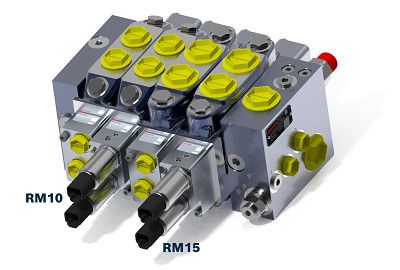Bosch Rexroth has introduced the RM10 and RM15 load sensing valve platform that, according to company officials, is easy to apply for today’s functional demands. The product is readily integrated into modern, energy efficient systems and features flexible assembly with no transition plate needed between the two distinct sizes.

The RM10 and RM15 are compact, general purpose, multi-application load sense directional control valves.
The new RM10 and RM15, with flow rates of 90 and 150 lpm respectively, are cost effective, compact, general purpose, multi-application load sense directional control valves from Bosch Rexroth, optimally designed for mobile application markets.
The product is based around an easy-to-configure, flexible assembly technique that allows for the quick, off-the-shelf configuration demanded in today’s fast paced mobile machine design, prototype and manufacturing environment. With no transition plate needed between the RM10 and RM15 or the current M4-12 portfolio, the valve line is an ideal fit providing optimum flexibility for machines that demand varying flow rates and functions, but have limited space due to industry regulations. The valves come equipped with common industry work ports and load sense relief cartridges.
Rexroth’s RM10 and RM15 are easily integrated into today’s energy efficient systems, working with low leakage demands at pump pressures of 280 bar and working port pressures at 320 bar – both optimized for today’s working functions in modern mobile applications.
Typical industry segments that can benefit from this product are CTL/SSL, AWP, refuse and municipal vehicles, work truck cranes, forklift trucks, telehandlers and compact construction equipment. Application functions include lift/lower tilt functions, outriggers, winches, coordinated boom control, attachment/auxiliary flow functions, broom/brush motor control and blade angle/tilt/rotate.
Bosch Rexroth
www.boschrexroth-us.com
Filed Under: Mobile Hydraulic Tips, Valves & Manifolds